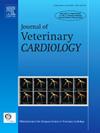Agreement of echocardiographic and catheterization-based methods of transpulmonary pressure gradient measurement in dogs
IF 1.3
2区 农林科学
Q2 VETERINARY SCIENCES
引用次数: 0
Abstract
Introduction/Objectives
Doppler echocardiographic estimation of transpulmonary pressure gradient (PG) is widely used to determine severity of pulmonary valve stenosis and indication for transcatheter intervention. The objective of this study was to describe agreement between Doppler echocardiographic methods of transpulmonary PG estimation and direct peak-to-peak pressure gradient at catheterization (PGcath) in dogs. We hypothesized that with reference to PGcath, mean echocardiographic PG (PGecho-mean) would have less bias than peak modal instantaneous echocardiographic PG (PGecho-peak).
Animals
Client-owned dogs with congenital pulmonary valve stenosis that underwent balloon pulmonary valvuloplasty at one of two veterinary teaching hospitals between June 2012 and May 2022 were included in this study.
Materials and Methods
Cases that underwent transthoracic echocardiography and subsequent balloon pulmonary valvuloplasty separated by 30 or fewer days were retrospectively identified. For each echocardiogram, average PGecho-mean (mmHg) and average PGecho-peak (mmHg) were calculated from stored spectral Doppler recordings. Peak right ventricular-to-peak pulmonary artery PG data (mmHg) were obtained from catheterization reports. Bland–Altman analysis was used to assess agreement between echocardiographic and catheterization data.
Results
Data from 209 dogs (n = 215 instances) were evaluated. Proportional bias, greater at higher gradients, was observed for PGecho-mean versus PGcath (P<0.001). A constant bias of −38.12 mmHg was observed for PGecho-peak versus PGcath (P=0.62). Bias for both echocardiographic variables had wide limits of agreement that increased with PG.
Conclusions
PGecho-mean and PGecho-peak underestimated and overestimated PGcath, respectively, preventing their interchangeability with PGcath.
狗的超声心动图和导管插入法跨肺压力梯度测量方法的一致性。
导言/目的:多普勒超声心动图估测的经肺动脉压力梯度(PG)被广泛用于确定肺动脉瓣狭窄的严重程度和经导管介入治疗的适应症。本研究的目的是描述多普勒超声心动图估测犬跨肺压力梯度的方法与导管插入时直接峰-峰压力梯度(PGcath)之间的一致性。我们假设,参照 PGcath,超声心动图 PG 平均值(PGecho-mean)的偏差将小于超声心动图 PG 峰值模态瞬时值(PGecho-peak):研究对象:2012 年 6 月至 2022 年 5 月期间在两家兽医教学医院中的一家接受球囊肺动脉瓣成形术的先天性肺动脉瓣狭窄患犬:回顾性地确定了接受经胸超声心动图检查和随后接受球囊肺动脉瓣成形术的病例,两者之间的间隔时间为 30 天或更短。根据存储的频谱多普勒记录计算出每张超声心动图的平均 PGecho-mean (mmHg) 和平均 PGecho-peak (mmHg)。右心室-肺动脉 PG 峰值数据(毫米汞柱)来自导管检查报告。使用 Bland-Altman 分析评估超声心动图数据与导管检查数据之间的一致性:评估了 209 只狗(n = 215 例)的数据。PGecho-mean与PGcath(Pecho-peak与PGcath(P=0.62))的比例偏差较大,梯度越高,偏差越大。两个超声心动图变量的偏差具有较大的一致性,且随着 PG 的增加而增加:结论:PGecho-mean和PGecho-peak分别低估和高估了PGcath,因此无法与PGcath互换。
本文章由计算机程序翻译,如有差异,请以英文原文为准。
求助全文
约1分钟内获得全文
求助全文
来源期刊

Journal of Veterinary Cardiology
VETERINARY SCIENCES-
CiteScore
2.50
自引率
25.00%
发文量
66
审稿时长
154 days
期刊介绍:
The mission of the Journal of Veterinary Cardiology is to publish peer-reviewed reports of the highest quality that promote greater understanding of cardiovascular disease, and enhance the health and well being of animals and humans. The Journal of Veterinary Cardiology publishes original contributions involving research and clinical practice that include prospective and retrospective studies, clinical trials, epidemiology, observational studies, and advances in applied and basic research.
The Journal invites submission of original manuscripts. Specific content areas of interest include heart failure, arrhythmias, congenital heart disease, cardiovascular medicine, surgery, hypertension, health outcomes research, diagnostic imaging, interventional techniques, genetics, molecular cardiology, and cardiovascular pathology, pharmacology, and toxicology.
 求助内容:
求助内容: 应助结果提醒方式:
应助结果提醒方式:


